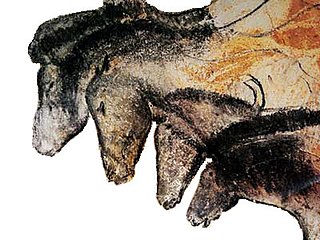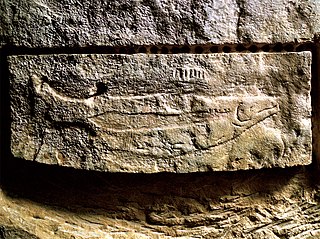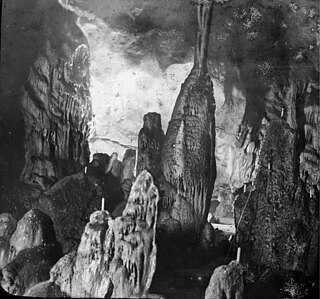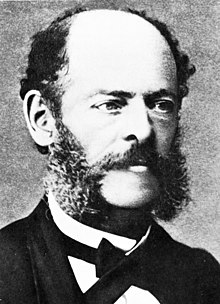
In archaeology, cave paintings are a type of parietal art, found on the wall or ceilings of caves. The term usually implies prehistoric origin, and the oldest known are more than 40,000 years old and found in the caves in the district of Maros. The oldest are often constructed from hand stencils and simple geometric shapes. More recently, in 2021, cave art of a pig found in Sulawesi, Indonesia, and dated to over 45,500 years ago, has been reported.

The Cave of Altamira is a cave complex, located near the historic town of Santillana del Mar in Cantabria, Spain. It is renowned for prehistoric cave art featuring charcoal drawings and polychrome paintings of contemporary local fauna and human hands. The earliest paintings were applied during the Upper Paleolithic, around 36,000 years ago. The site was discovered in 1868 by Modesto Cubillas and subsequently studied by Marcelino Sanz de Sautuola.

The Chauvet-Pont-d'Arc Cave in the Ardèche department of southeastern France is a cave that contains some of the best-preserved figurative cave paintings in the world, as well as other evidence of Upper Paleolithic life. It is located near the commune of Vallon-Pont-d'Arc on a limestone cliff above the former bed of the river Ardèche, in the Gorges de l'Ardèche.
Below are notable events in archaeology that occurred in 1880.

Henri Édouard Prosper Breuil, often referred to as Abbé Breuil, was a French Catholic priest, archaeologist, anthropologist, ethnologist and geologist. He is noted for his studies of cave art in the Somme and Dordogne valleys as well as in Spain, Portugal, Italy, Ireland, China with Teilhard de Chardin, Ethiopia, British Somali Coast Protectorate, and especially Southern Africa.

Émile Cartailhac was a French prehistorian, sometimes regarded as one of the founding fathers of the studies of the cave art.

Font-de-Gaume is a cave near Les Eyzies-de-Tayac-Sireuil in the Dordogne department of south-west France. The cave contains prehistoric polychrome cave paintings and engravings dating to the Magdalenian period. Discovered in 1901, more than 200 images have been identified in Font-de-Gaume. Along with other nearby prehistoric archeological sites, Font-de-Gaume was inscribed on the UNESCO World Heritage List in 1979 as the Prehistoric Sites and Decorated Caves of the Vézère Valley.

The Cueva del Castillo, or Cave of the Castle, is an archaeological site within the complex of the Caves of Monte Castillo, in Puente Viesgo, Cantabria, Spain.

Puente Viesgo is a municipality in Cantabria, Spain. Caves have been discovered near Puente Viesgo that contain rock art and artefacts dating back to the Middle and Upper Paleolithic.

La Marche is a cave and archaeological site located in Lussac-les-Châteaux, a commune in the department of Vienne, western France. It is an archaeological site that has engendered much debate that has not been resolved to date. The carved etchings discovered there in 1937 show detailed depictions of humans and animals that may be 15,000 years old. The cave paintings at this site, however, are controversial and many doubt their authenticity.

The Prehistoric Sites and Decorated Caves of the Vézère Valley is a UNESCO World Heritage Site in France since 1979. It specifically lists 15 prehistoric sites in the Vézère valley in the Dordogne department, mostly in and around Les Eyzies-de-Tayac-Sireuil, which has been called the "Capital of Prehistory". This valley is exceptionally rich in prehistoric sites, with more than 150 known sites including 25 decorated caves, and has played an essential role in the study of the Paleolithic era and its art. Three of the sites are the namesakes for prehistoric periods; the Micoquien, Mousterian, and Magdalenian. Furthermore, the Cro-Magnon rock shelter gave its name to the Cro-Magnon, the generic name for the European early modern humans. Many of the sites were discovered or first recognised as significant and scientifically explored by the archaeologists Henri Breuil and Denis Peyrony in the early twentieth century, while Lascaux, which has the most exceptional rock art of these, was discovered in 1940.

The Rouffignac cave, in the French commune of Rouffignac-Saint-Cernin-de-Reilhac in the Dordogne département, contains over 250 engravings and cave paintings dating back to the Upper Paleolithic. In conjunction with other caves and abris of the Vézère valley, the Rouffignac cave was classified a Monument historique in 1957 and a World Heritage Site in 1979 by UNESCO as part of the Prehistoric Sites and Decorated Caves of the Vézère Valley.

The Cantabrian caves' unique location make them an ideal place to observe the settlements of early humans thousands of years ago. The magnificent art in the caves includes figures of various animals of the time such as bison, horses, goats, deer, cattle, hands and other paintings. Archaeologists have found remains of animals such as bears, the remains of arrows and other material indicating a human presence; these artifacts are now found mostly in the Regional Museum of Prehistory and Archaeology of Cantabria.

The Caves of Monte Castillo, located in the Cantabrian town of Puente Viesgo, contain one of the most important Paleolithic sites in the region. The complex of karstic caves is on the slopes of Monte Castillo, a hill south of Puente Viesgo, with an elevation of 354 m. It includes four out of the eighteen caves listed as World Heritage of UNESCO since July 2008 under the title of Cave of Altamira and Paleolithic Cave Art of Northern Spain: El Castillo, Las Chimeneas, and La Pasiega and Las Monedas. In addition, the complex includes a minor fifth cave, La Flecha. The caves are located along the Pas river in the Castillo mountain, squarely at the intersection of three valleys and near the coast.

Rock art has been produced in Europe since the Upper Palaeolithic period through to recent centuries. It is found in all of the major regions of the continent. One of the most famous examples of parietal art is the Grotte Chauvet in France. The cultural purpose of these remnants of the Paleolithic and other periods of prehistoric art is not known. However, some theories suggest that, because these paintings were created in parts of the caves that were not easily accessed, it is unlikely that they were intended simply as decoration.

The Caves of Gargas in the Pyrenees region of France are known for their cave art from the Upper Paleolithic period - about 27,000 years old.

Coliboaia Cave is located in Apuseni Natural Park, Câmpani, Bihor County, Romania. It may contain the oldest known cave paintings of Central Europe, radiocarbon dated to 32,000 and 35,000 years BP, corresponding to the Aurignacian and Gravettian cultures of the Paleolithic period.

Édouard Louis Stanislas Piette was a French archaeologist and prehistorian.

Finding Altamira is a 2016 Spanish biographical drama film starring Antonio Banderas, and directed by Hugh Hudson. It is Hudson's first fiction film since I Dreamed of Africa in 2000, and his final film before his death in 2023.

The Caves of Poço Velho are located in the centre of Cascais in the Lisbon district of Portugal. Their use, primarily as a necropolis, is believed to date back to the paleolithic era.




















